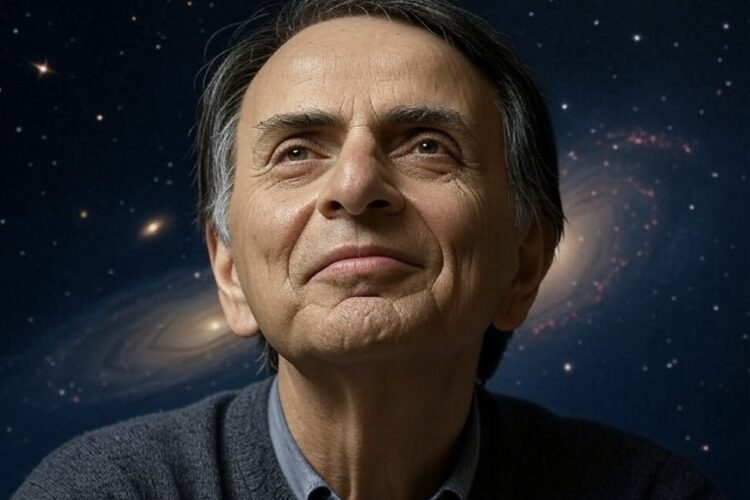Carl Sagan, a renowned astronomer and science communicator, transformed our understanding of the universe. Born in 1934, he studied Venus’s greenhouse effect and contributed to NASA’s Viking and Voyager missions, including the Voyager Golden Record. A SETI advocate, he co-developed the Drake Equation to estimate alien civilizations. His TV series Cosmos and books like Pale Blue Dot and The Demon-Haunted World popularized science, earning a Pulitzer Prize. Sagan’s skepticism, outlined in his “Baloney Detection Kit,” countered pseudoscience. At Cornell, he advanced planetary science and astrobiology. His humanistic philosophy, emphasizing Earth’s fragility, inspired environmental and anti-nuclear activism. Despite criticism for popularizing science, Sagan’s 600+ papers proved his rigor. He died in 1996, but his legacy endures through Cosmos reboots and ongoing SETI efforts.
Long Version
Carl Sagan, a name synonymous with the wonders of the cosmos, was an astronomer, astrophysicist, and science communicator whose work reshaped how humanity views its place in the universe. Renowned for his ability to translate complex scientific concepts into accessible narratives, Sagan’s legacy spans planetary science, astrobiology, and the search for extraterrestrial life, while his humanistic philosophy and skepticism continue to inspire critical thinking. This article delves into every facet of Sagan’s life, from his groundbreaking research to his cultural impact as a public intellectual, offering a comprehensive exploration of his contributions to science and society.
Early Life and Academic Foundations
Born on November 9, 1934, in Brooklyn, New York, Carl Edward Sagan grew up in a working-class Jewish family. His early fascination with the stars was sparked by visits to the Hayden Planetarium and science fiction novels, igniting a lifelong passion for astronomy. Sagan pursued his academic journey at the University of Chicago, earning a bachelor’s degree in 1955 and a Ph.D. in astronomy and astrophysics in 1960. His doctoral research, supervised by Gerard Kuiper, focused on the greenhouse effect in Venus’s atmosphere, a pioneering study that laid the groundwork for his contributions to planetary science.
Sagan’s early career included stints at Harvard University and the Smithsonian Astrophysical Observatory, where he investigated planetary atmospheres and surfaces. His work on Venus’s extreme temperatures, published in the 1960s, confirmed the planet’s runaway greenhouse effect, a concept that later informed discussions on Earth’s climate. This research, conducted alongside his involvement in NASA’s early planetary missions, established Sagan as a leading figure in the nascent field of astrobiology.
Contributions to Planetary Science and NASA Missions
Sagan’s scientific career was deeply intertwined with NASA’s exploration of the solar system. At the Jet Propulsion Laboratory (JPL), he contributed to the Mariner, Viking, Pioneer, and Voyager missions, applying his expertise to understand planetary environments. His studies of Mars, conducted through the International Planetary Patrol, revealed seasonal changes in the planet’s surface, initially misinterpreted as signs of life but later attributed to dust storms. These findings, derived from the Viking missions, underscored Sagan’s commitment to rigorous scientific inquiry, even when results challenged popular expectations.
Sagan’s work on the Voyager program was particularly iconic. He played a key role in designing the Voyager Golden Record, a phonograph record sent aboard Voyager 1 and 2 to communicate humanity’s story to potential extraterrestrial civilizations. Curated with his wife and collaborator, Ann Druyan, the record included sounds, music, and images from Earth, embodying Sagan’s humanistic vision of interstellar communication. Similarly, the Pioneer plaque, co-designed by Sagan for the Pioneer 10 and 11 spacecraft, depicted human figures and Earth’s location, a bold gesture in the search for extraterrestrial intelligence (SETI).
The Search for Extraterrestrial Life and the Drake Equation
Sagan’s fascination with extraterrestrial life was a cornerstone of his career. He was a passionate advocate for SETI, promoting the scientific search for alien civilizations through radio signals. His work on the Drake Equation, developed with Frank Drake, provided a framework for estimating the number of communicative civilizations in the galaxy. While speculative, the equation sparked rigorous debate and remains a touchstone in astrobiology.
Sagan’s interest in extraterrestrial life extended to his skepticism of UFO claims, a stance that earned him both admiration and criticism. He argued that extraordinary claims require extraordinary evidence, a principle encapsulated in his “Baloney Detection Kit” from The Demon-Haunted World. This toolkit, designed to distinguish science from pseudoscience, reflected Sagan’s commitment to scientific skepticism and critical thinking, themes that permeated his public outreach.
Literary and Media Contributions: Cosmos and Beyond
Sagan’s ability to bridge the gap between science and the public made him a cultural icon. His 1980 television series, Cosmos: A Personal Voyage, co-written with Ann Druyan and Steven Soter, remains a landmark in science communication. Watched by over 500 million people worldwide, the 13-episode series explored the universe’s vastness, from the Big Bang to the evolution of life. Sagan’s poetic narration, punctuated by phrases like “billions and billions” of stars, captivated audiences, while the series’ companion book became a bestseller.
Sagan’s literary output was equally prolific. His 1977 book, The Dragons of Eden, explored the evolution of human intelligence, earning a Pulitzer Prize for General Nonfiction. Broca’s Brain (1979) delved into the intersection of science and philosophy, while Pale Blue Dot (1994) reflected on humanity’s fragility, inspired by a Voyager 1 photograph of Earth as a tiny speck in space. Sagan’s novel Contact (1985), later adapted into a 1997 film, imagined humanity’s first encounter with an alien civilization, blending scientific rigor with philosophical depth.
His 1996 book, The Demon-Haunted World: Science as a Candle in the Dark, addressed the dangers of pseudoscience and superstition. Advocating for skepticism and the scientific method, Sagan critiqued phenomena like astrology and alien abductions, offering tools to navigate a world rife with misinformation. This work cemented his role as a defender of rational thought, countering what he termed the “Sagan effect”—the misconception that popularizing science undermines research credibility.
Philosophical and Social Impact
Sagan’s humanistic philosophy emphasized humanity’s shared destiny and the need for global cooperation. His concept of the “Pale Blue Dot” underscored Earth’s fragility, urging environmental stewardship and peace. In the 1980s, Sagan co-authored studies on nuclear winter, warning of the catastrophic consequences of nuclear war. His activism, including protests against nuclear proliferation, reflected his belief that science must serve humanity’s survival.
As a professor at Cornell University, where he spent much of his career, Sagan mentored students and advanced research in planetary science and astrobiology. His involvement with organizations like the American Association for the Advancement of Science (AAAS) and the Committee for Skeptical Inquiry (CSI) amplified his influence, promoting science education and skepticism worldwide.
Personal Life and Legacy
Sagan’s personal life, particularly his collaboration with Ann Druyan, was integral to his work. Married in 1981, they co-authored Cosmos and other projects, blending their shared passion for science and storytelling. Sagan’s earlier marriages to biologist Lynn Margulis and artist Linda Salzman also shaped his interdisciplinary approach, with Salzman contributing to the Pioneer plaque’s design.
Sagan’s death on December 20, 1996, from pneumonia related to myelodysplasia, marked the loss of a singular voice in science. Yet his legacy endures through his books, the ongoing SETI program, and the cultural resonance of Cosmos. The 2014 reboot, Cosmos: A Spacetime Odyssey, hosted by Neil deGrasse Tyson, introduced Sagan’s vision to a new generation, while Ann Druyan’s continued advocacy ensures his ideas remain vital.
Challenges and Controversies
Sagan’s career was not without challenges. The “Sagan effect” led some academics to question his focus on popularization, though his research contributions—over 600 published papers—refuted such critiques. His skepticism of UFOs and paranormal claims drew ire from believers, while his secular humanism occasionally clashed with religious perspectives. Despite these tensions, Sagan’s commitment to evidence-based reasoning never wavered, earning him respect as a principled scientist.
Conclusion: A Beacon of Cosmic Perspective
Carl Sagan was more than an astronomer or astrophysicist; he was a public intellectual who transformed how we understand the universe and our place within it. Through his work with NASA, his advocacy for SETI, and his masterpieces like Cosmos and Pale Blue Dot, Sagan invited humanity to embrace curiosity, skepticism, and wonder. His “Baloney Detection Kit” and critiques of pseudoscience remain essential tools in an era of misinformation, while his humanistic vision inspires efforts to protect our fragile planet.
Sagan’s phrase, “We are made of starstuff,” encapsulates his ability to weave science and poetry into a unifying narrative. As we continue to explore the cosmos, from Mars to distant exoplanets, Sagan’s legacy as a cosmic communicator endures, guiding us toward a future where knowledge illuminates the dark and humanity thrives on the pale blue dot we call home.
Hashtags For Social Media
#carlsagan #cosmos #spaceexploration #astronomy #sciencecommunication #seti #extraterrestrial #palebluedot #voyagergoldenrecord #drakeequation #scientificskepticism #demonhauntedworld #planetaryscience #nasa #astrobiology #spaceenthusiast #sciencehistory #humanism #skepticism #scienceeducation #pulitzerprize #contactnovel #ufoskeptic #cosmicperspective #billionsandbillions #spacelegacy #scienceinspiration #astronomerlife #universewonder #stargazing
Related Questions, Words, Phrases
carl sagan biography | who was carl sagan | what did carl sagan discover | carl sagan cosmos series | carl sagan books list | carl sagan extraterrestrial life | carl sagan seti contributions | carl sagan voyager golden record | carl sagan drake equation explained | carl sagan pale blue dot meaning | carl sagan scientific skepticism | carl sagan baloney detection kit | carl sagan the demon-haunted world summary | carl sagan planetary science research | carl sagan nasa missions | carl sagan venus greenhouse effect | carl sagan mars studies | carl sagan nuclear winter theory | carl sagan humanism philosophy | carl sagan cornell university career | carl sagan pulitzer prize book | carl sagan contact novel analysis | carl sagan skeptic ufo claims | carl sagan science communication impact | carl sagan astrobiology work | carl sagan legacy in astronomy | carl sagan famous quotes | carl sagan billions and billions phrase | carl sagan contributions to space exploration | carl sagan pioneer plaque design | carl sagan early life and education | carl sagan ann druyan collaboration | carl sagan death and legacy | carl sagan sagan effect criticism | carl sagan role in popularizing science








